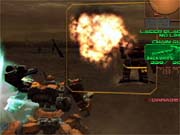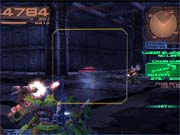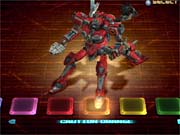If anything is better than piloting a giant robot, it's actually building one. From Software's Armored Core series, now spanning six games and dating back to a 1997 release for the PlayStation, has always centered on this idea. Armored Core 3 dares to brand itself as the second true sequel to the original, yet in fact, it's quite similar to all its predecessors. It's a mission-based third-person action sim in which you'll spend almost as much time tinkering with your own giant robots as you'll spend engaged in battles against enemy forces. As a mercenary working for the highest bidder, you'll get to take on a variety of quick, combat-intensive sorties that earn you more money, which in turn earns you better equipment. Armored Core 3 will appeal to series fans on the same levels that its predecessors have, and it offers fairly accessible controls and a good premise for everyone else. The game's unspectacular presentation and its dated design do interfere with its success, though.

Armored Core 3 takes place in a grim future that may sound pretty familiar: The world is being picked apart by a small number of megacorporations but is yet more at the mercy of an omniscient AI construct known only as the Controller. Your role in all this, mostly, is just to make a buck. You're a Raven, a mercenary whose weapon is a giant robot--known as an armored core, or just AC for short. Apparently, AC manufacturing is quite the lucrative business, because plenty of competitive aftermarket parts are available for souping up your AC in any number of different ways. You can buy new heads, arms, legs, and torsos--as well as weapons, defensive countermeasures, boosters, sensors, radiators, and a variety of supplemental parts. There are more than a dozen different categories of parts, and many are available within each category. You can even paint your AC with a custom scheme and brand it with your very own emblem--artistic types will be pleased to know that Armored Core 3 is one of the few PlayStation 2 games to support a mouse, but only for the purposes of painting your emblem.
Armored Core 3 has a couple of other such odd technical features. The game supports Dolby Pro Logic II setups for enhanced audio, though the game's actual musical score (all subdued, tinny techno) and its audio effects (hushed and mostly bland, though reasonably varied) won't make much of a showcase for a high-end sound system. The voice acting found in the game's mission briefings and during the missions themselves is surprisingly good, though. Though Armored Core 3's main single-player mode revolves around a mission-based structure, there's also an arena mode where you can pit your AC against a number of increasingly difficult computer-controlled foes in one-on-one battles for prize money. Optionally, you can play this mode against another human player in split-screen, or you can even use the PS2's i.Link feature to daisy-chain up to four PS2s with multiple copies of Armored Core 3 for some four-player action. Good luck getting that setup together, though it's comforting to know that it's there.

Features like these would be commendable in most any game, though in Armored Core 3, they call attention to some of the things the game seems to be missing. The most disappointing omission--and perhaps it's not entirely fair to criticize the game for this--is the absence of online play. Armored Core 3 actually would have made an excellent candidate for use with Sony's recently released PS2 network adapter, which could have let you take your own custom AC online to see how it fared against everyone else. The game automatically ranks your AC in terms of the quality of its design, so online Armored Core 3 could have easily pit players of the same relative weight division against each other. At any rate, the lack of online play represents a real missed opportunity for this game. If nothing else, online features might have helped Armored Core 3 garner something larger than a niche audience.
Armored Core 3's production values aren't that great. Though its PlayStation 2 predecessors looked good for their time, it's been over a year since the last game. Standards for graphics have improved a lot since then, but Armored Core 3's visuals aren't much better than those in Armored Core 2: Another Age. The designs of the different ACs look as good as ever--the four-legged spiderlike ones, the tank-treaded ones, and the hovering ones are especially distinctive. You don't get a good sense of the large scale of your ACs, though at least they're animated smoothly, so the game still ends up looking good despite some dark, murky environments and generally bland textures.
Actually controlling your AC is pretty intuitive, but the controls could have been done better. You use the left analog stick to move about, and the face buttons let you fire or switch between your weapons and also let you use your secondary attack--usually some sort of close-ranged strike. With most ACs, you can also leap into the air or use a rocket boost to fly around for a while. You auto-acquire targets within a given radius (depending on your sensors), but to hit some of the peskier ones, you'll have to manually aim up or down using the shoulder buttons. Why the right analog stick isn't used for aiming is somewhat of a mystery, though to be sure, the controls feel clunkier the way they are, and maybe that's an accurate simulation of operating an AC.

Cores can be surprisingly nimble, though as mentioned, you can outfit them in a variety of ways--from pure brawn to pure speed, and anywhere in between. It's always been the strength of the series that it basically lets you play to your own style. Save up for some high-end sensors and buy the most heavy-duty armor and weapons that you can afford, and you can finish most missions just by plowing through anything that gets in your way. Alternately, in a speedy AC, the controls can be quite responsive, allowing you to avoid taking damage both by dodging and also by using defensive countermeasures. Since repair costs for your AC are deducted automatically from your mission fee and can be quite steep, it's nice to know that the game thusly encourages you to not simply muscle your way through every situation.
Mission design in Armored Core 3 is varied and quite good, offering up a variety of conventional but enjoyable scenarios. You'll occasionally have to defend targets or areas or explore some unknown locations, but most of the missions are action-intensive, as well they should be. Reconnaissance data in the mission briefings tends to be pretty limited, but that's usually just to provide some suspense--you should still be able to get through many missions on your first attempt. Perhaps it's easy to see why the Armored Core formula hasn't changed in so long: It still works. The short-but-sweet missions encourage you to keep playing, and the high cost of some of the best gear is an even better incentive to rake in the credits.

Buying, selling, and rearming your ACs is a bit cumbersome, but you'll figure it out. There's a separate interface for purchasing new parts and for actually equipping or selling them, so you'll need to keep a mental record of what you have and what you need. Parts are sold categorically, so you'll have to flip through the dozen-or-so part classes then flip through the available parts in that category to find the one you want. Each part is rated by a variety of statistics, from weight to energy drain to heat discharge, and these numbers can be a bit overwhelming at first. Fortunately, Armored Core 3 is a lot more liberal about how it lets you design your AC than some of the earlier games in the series. Even if you do exceed your legs' weight capacity or something like that, you'll likely still be able to take your AC into battle--it'll just operate at less-than-optimal capacity. Also, you can have up to three different ACs in your garage so that you won't need to totally reengineer your favorite AC in order to get through a mission that requires a particular strategy.
Armored Core 3 has a good amount of replay value since there's so much variety in how you can build your AC, and it has a good number of missions, to boot. Though the game's battles are partly decided while you're building your AC in the garage, the actual gameplay of Armored Core 3 is still responsive and action-oriented enough that it should appeal to fans of giant robot action games like Virtual On. It's not the prettiest game around, and it's basically similar to what the series has always offered, but this latest Armored Core is still a good, solid game.